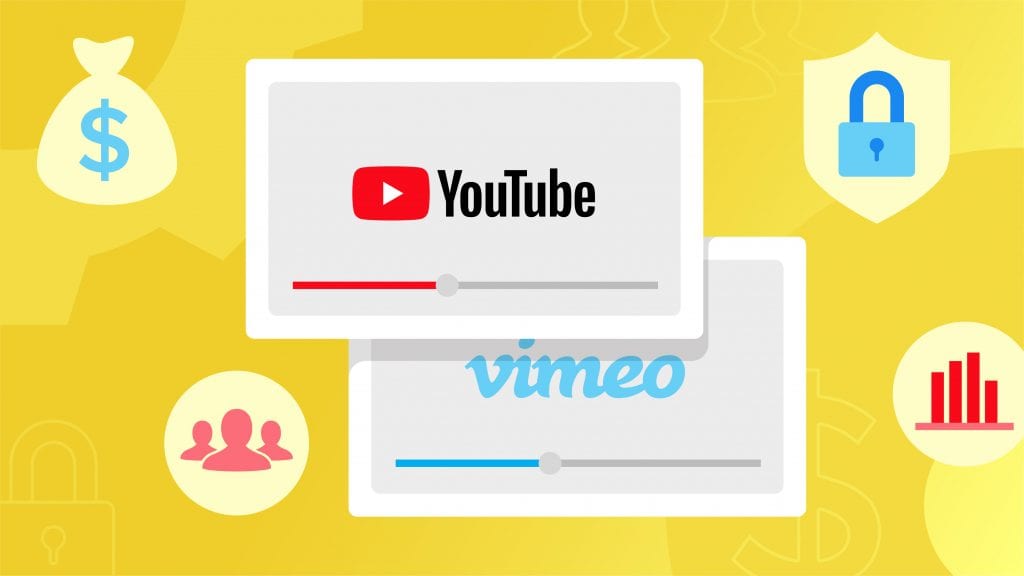Vimeo vs. YouTube: Video Hosting Platform Comparison to Help You Decide
YouTube and Vimeo both are great video hosting platforms. Learn more about YouTube vs. Vimeo and which is a better option for you.

If you want to be a video content creator, chances are you’ve considered publishing your videos on YouTube and Vimeo—the most popular video platforms. While these hosting platforms look the same, they have distinct pros and cons.
Get Captions for YouTube or Vimeo
That’s precisely why we want to show you the key differences between Vimeo and YouTube.
Pricing: Vimeo vs. YouTube
Vimeo and YouTube have different pricing plans.
Vimeo has higher prices so businesses and content creators can get an ad-free viewing experience.
Their most affordable premium plan is the “Plus” option priced at $7 per month with access to 250GB storage per year. On top of that, you can join their Pro, Business, or Premium plan for higher upload limits, live stream features, and SEO or Google Analytics options.
How to Add Captions & Subtitles to Vimeo Videos
Content creators on a budget can also join their basic plan which offers 500MB storage per week of upload space and up to 5GB total account storage.
Meanwhile, it’s free to upload and watch videos on YouTube because they primarily earn revenue through ads.
However, the YouTube Premium subscription lets viewers get an uninterrupted and ad-free viewing experience. With the absence of ads, YouTube also lets creators earn revenue based on the views they get from Premium subscribers.
Audience size: Vimeo vs. YouTube
Of course, publishers want their videos to get lots of views, so let’s take a look at how these video platforms stack up in terms of audience size.
YouTube has over two billion users. According to Oberlo, 79% of Internet users have a YouTube account. Need more proof? Check out these YouTube stats and facts.
Vimeo has 240 million active users per month. The audience size is smaller so videos on Vimeo have better chances of getting discovered in niche communities. Thanks to its ad-free experience, Vimeo is the ideal platform for documentaries or feature-length films.
Privacy options: Vimeo vs YouTube
Vimeo and YouTube offer various privacy settings to determine who can view your content.
Vimeo users can select from various privacy options such as “Anyone”, “Only me”, “Only people I follow” and “Only people I choose”.
What’s more, users availing of their premium plans can also create password-protected videos or private links. This option is ideal for professionals who want to share videos privately with clients or their team.
Meanwhile, YouTube offers three basic privacy settings public, unlisted, and private. Unlisted videos can only be accessed by people with the URL and private videos can only be accessed by you or specified users.
Monetization schemes: Vimeo vs YouTube
Publishers who want to earn money from their video should check out the monetization options available on both platforms.
YouTube Partner Program (YPP) lets creators earn revenue from ads shown in their YouTube video. However, creators must hit 10,000-lifetime views on their channel to turn on monetization.
Creators can also join affiliate programs, ask for donations, and create sponsored content.
Vimeo is an ad-free platform so you cannot earn revenue from ads—though premium plan users can still earn money through Vimeo on Demand. Here, professional filmmakers can sell their content so viewers can get full access.
Analytics: Vimeo vs YouTube
Both platforms have an analytics dashboard.
Premium Vimeo users can get an overview of impressions, likes, plays, and other metrics. They can also determine the location or region of viewers, identify skipped parts, and create or export custom reports.
On the flip-side, YouTube also offers the same features, though it has more advanced analytics options.
YouTube Analytics can determine gender, age, audience retention of viewers. Plus, it can determine the number of videos shared, revenue sources, traffic sources among many others.
Captioning integrations
Both Vimeo and YouTube let content creators add English captions and foreign language subtitles to their videos.
Rev.com has integrations with both Vimeo and YouTube for closed captioning & subtitling online videos. Just link your accounts, then order Rev’s 99%-accurate captions.
Get Captions for YouTube or Vimeo
Closed captions & subtitles make videos accessible for people who are deaf and hard of hearing, and an incredible number of people watch videos without sound, particularly on their mobile devices. So closed captioning & subtitling videos is important for any video creator.
Here’s how it’s done:
Add Captions to YouTube Videos
Add Captions to Vimeo Videos
Updating videos: Vimeo vs YouTube
Despite double-checking, we may notice a slight mistake in the video once it’s posted.
With Vimeo, creators can replace the video without discarding the initial video stats.
On the other hand, YouTube does not enable video updates. Once it’s posted, there is no turning back. Your only option is to delete the initial video and replace it with a new version.
Video editing options: Vimeo vs YouTube
Vimeo and Youtube have robust editing capabilities.
Vimeo video editor lets creators build higher quality videos through custom video templates. Users can customize the colors, layouts, and fonts to create polished videos.
Plus, you can also add tags, descriptions and use their video marketing tools so it gets found on search results.
In the meantime, the Youtube Creator Studio also lets users trim, add audio tracks and make basic edits to guarantee professional video quality.
Which video hosting platform is better?
Both Vimeo and YouTube are great for different purposes and different people.
Vimeo offers an ad-free experience which may be ideal for filmmakers posting feature-length films. It is also recommended for businesses who want to post content without ad interruptions.
In contrast, YouTube is ideal for social media influencers, marketing promotions, and basic video content. Not only is it free to upload online videos, but you can also access analytics and editing features.
Subscribe to The Rev Blog
Sign up to get Rev content delivered straight to your inbox.



